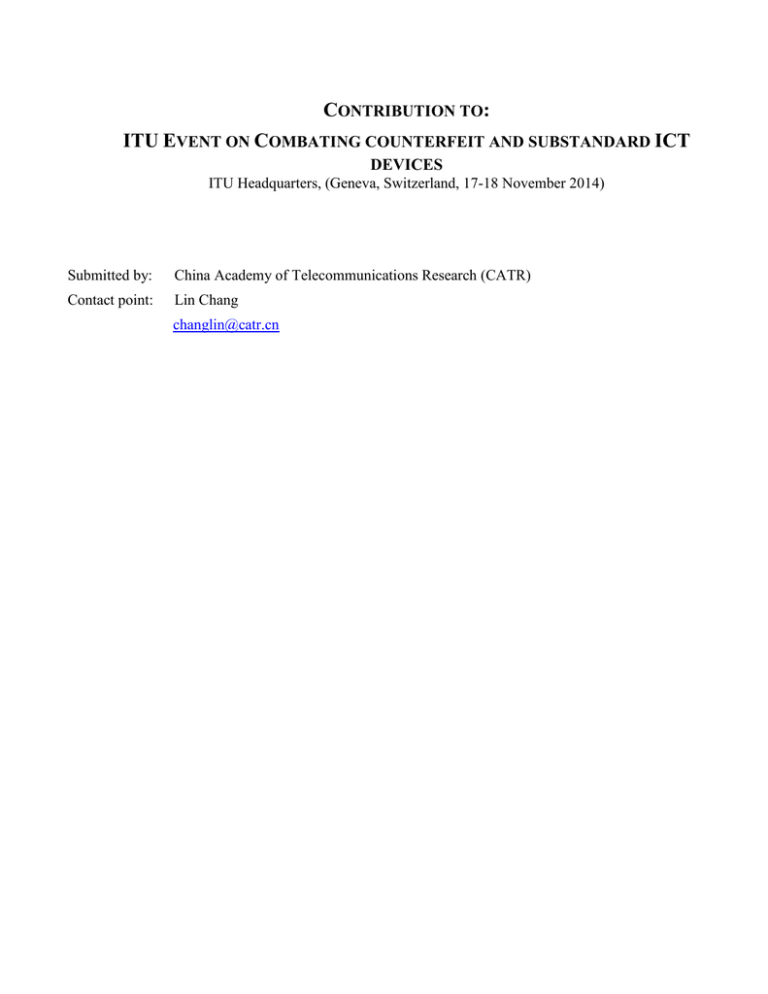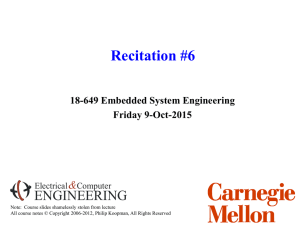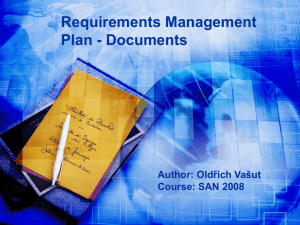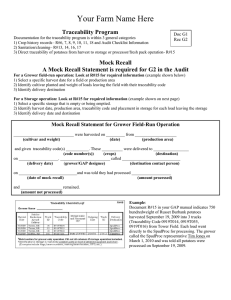C : ITU E
advertisement

CONTRIBUTION TO: ITU EVENT ON COMBATING COUNTERFEIT AND SUBSTANDARD ICT DEVICES ITU Headquarters, (Geneva, Switzerland, 17-18 November 2014) Submitted by: China Academy of Telecommunications Research (CATR) Contact point: Lin Chang changlin@catr.cn -2- The experience of Information System for Food Quality and Safety Traceability in China 1. Introduction For most countries, food and agriculture are very important parts of trade and economics, especially for developing countries where food is insecurity and hunger is commonplace. China, since the population has come to 1.3 billion, not only needs to solve the lack of food, also must pay attention to food quality and safety. Nowadays, the main food of China, such as grain, fruit, meat, eggs and aquatic product, has occupied the first place in the world. Therefore, the food quality and safety in China are extremely significant. In order to solve the problem, Chinese government actively takes a series of policies to promote the advantage of using the Information System for Food Quality and Safety Traceability. In February 2009, <Food Safety Law of the People’s Republic of China> has been passed to clear the key points and requirements of the information system. In May 2013, Ministry of Industry and Information Technology of the People's Republic of China released the < Information System for Food Quality and Safety Traceability of pilot work program>, and the program plans to construct system platform of food quality and safety traceability in 2 to 5 years. In June 2014, the Information System for Food Quality and Safety Traceability was officially launched. The system which regards food industrial enterprises as the main body has covered six infant formula milk powder pilot enterprises. The consumers can trace all of the products’ information, such as production, transportation, and usage by smart phone or on the website. It is highly expected that the system would stem into almost all related industries. By connecting each step, like production, inspection, regulation, and consumption, the Information System for Food Quality and Safety Traceability issues the food an E-ID (electronic identification), to track all the information. The system can track the information from the end point to the starting point, just like from the dining table to the farm. In addition, the system will establish a data base for food quality and safety. 2. Objectives and Strategies Objectives: (1) Monitor the food quality in the whole process, discover and solve problems timely and effectively, and reduce the possibility of food insecurity. (2) Prevent the circulation of counterfeit commodities, amend the sales chain, and protect good company’s brand. (3) Make it easier for corporation to control the production process, to avoid over-production and resource waste, and to decrease the cost of delivery. (4) The government can analyze the data from the Information System for Food Quality and Safety Traceability for better market regulation and monitoring. Strategies: -3- Collect, monitor, and analyze the information about every food product’s safety, ingredients, and inventory in every step from production to consumption using ICT. Currently, as smart phones are widely used in society, ordinary consumers can track all the information of a food product using their phones and decide whether to purchase. This can effectively guarantee consumer’s right of knowing and selection. 3. Activities Implemented The contribution will take an example of dairy industry and explain the basic points of Information System for Food Quality and Safety Traceability. (1) Information collecting system of raw materials. Make an ear tag for a cow using RFID, then record the cow’s health condition, reproduction, and disease management. This information will be restored in the production data base, to support the information system. (2) The electronic recording system in the production process. The manufacturing factory will record the food materials’ production date, expiration, original place into QR code, and then stick the code on the package. Once the processing factory receives the package, it can have all the information it needs and process the product as required. The processing factory will add a new QR code, including food’s name, ingredients, and date, to the original code, for the next step. (3) Delivery track system. Using RFID technology, the system can read the information on the truck (with GPS and temperature detector) and RFID tag of food package, then send data to Information System for Food Quality and Safety Traceability on a timely basis. This can offer a better inventory management and lower the cost of delivery. (4) System platform for basic information. By scanning the QR code, consumers can check the date, manufacture, certificate, and ingredients. Also, consumers can acquire the information about credit evaluation, instruction, and quality inspection report. In the future, the QR code will include all the information about every can of milk power which can be tracked backward to its manufacture farm and forward to its distribution market. 4. Outcomes Achieved (1) In June 2014, Ministry of Industry and Information Technology of the People's Republic of China, together with other government institutions and companies, built the Information System for Food Quality and Safety Traceability. The system is composed of companies and supported by government. Meanwhile, it improves consumers’ notion of food quality and safety and provides them an authoritative way to check the information of food product. (2) By June 13, 2014, the Information System for Food Quality and Safety Traceability has absorbed six infant formula milk powder pilot enterprises. These corporations have accomplished all the technical modifications and improvements as required. Their products with the QR code on package have entered markets, which contains up to 31 kinds of information and reports 42,008,200 pieces of data to the public database. -4- (3) Currently, “Food Traceability General Specification” and “Food Traceability Code and Mark Specification” have been approved by government departments. Combining experience and practice, some relevant norms and standards for the industry, like “System of Food Quality and Safety Traceability for Infant Formula Milk Powder Industry”, are also being drafted. 5. Challenges and Success Factors Challenges: The technology for establishing Information System for Food Quality and Safety Traceability is complicated, and the construction and application of related hardware, software, and database can generate high cost, which will reduce companies’ internal demand and positivity. Success Factors: The success for Information System for Food Quality and Safety Traceability is to let the food manufactures to realize how important it is. On the other side, the government needs to impart these relevant ideas to consumers, to enhance companies’ will of constructing the system indirectly through improving consumers’ cognition and usage rate of the Information System for Food Quality and Safety Traceability. 6. Next Steps and Proposal The Information System for Food Quality and Safety Traceability has come to a good stage. On the next stage, on the technological side, the system need to be researched and developed at cost saving technology. On the non-tech side, the system shall pay attention to further enrich the system and production chain, such as perfecting recall process and strengthening the organization scale of agriculture industry.



